Unit 4 Natural disasters - Reading and Thinking 课件 新人教版 必修一
文档属性
| 名称 | Unit 4 Natural disasters - Reading and Thinking 课件 新人教版 必修一 |  | |
| 格式 | pptx | ||
| 文件大小 | 12.7MB | ||
| 资源类型 | 试卷 | ||
| 版本资源 | 人教版(2019) | ||
| 科目 | 英语 | ||
| 更新时间 | 2024-11-02 21:31:23 | ||
图片预览

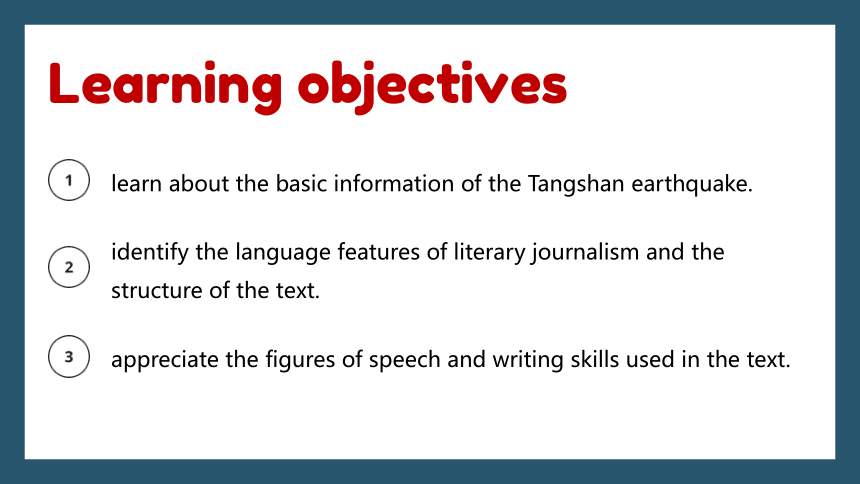
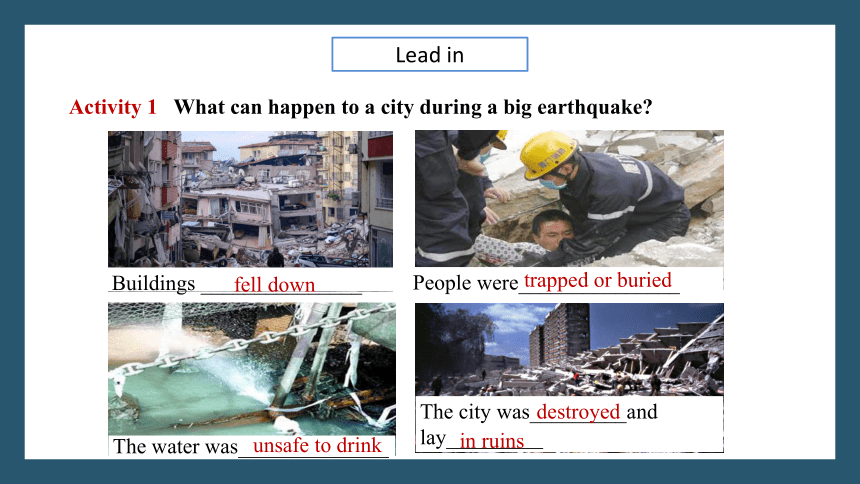
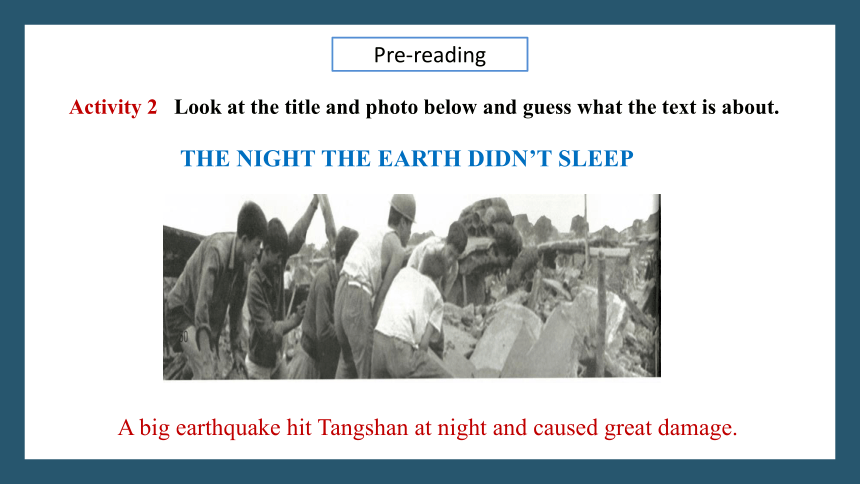

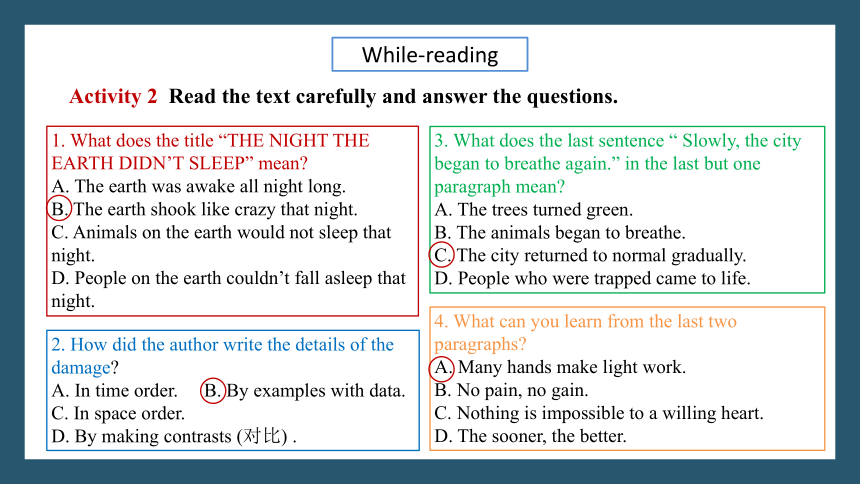
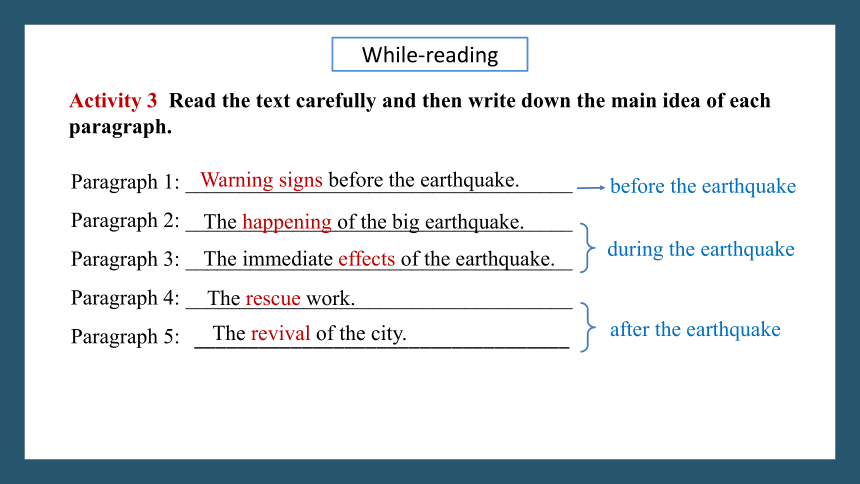
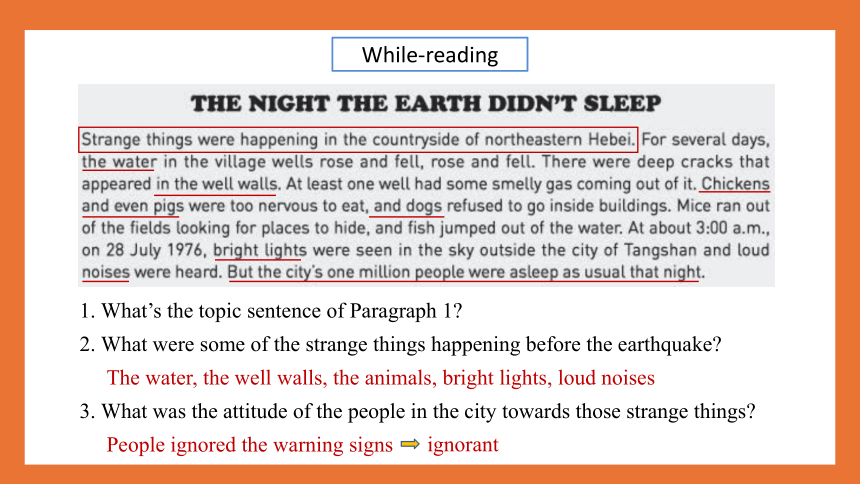

文档简介
(共23张PPT)
NATURAL DISASTERS
Reading and Thinking
learn about the basic information of the Tangshan earthquake.
Learning objectives
identify the language features of literary journalism and the structure of the text.
appreciate the figures of speech and writing skills used in the text.
Lead in
Activity 1 What can happen to a city during a big earthquake
People were_______________
trapped or buried
The water was______________
unsafe to drink
The city was_________and lay_________
destroyed
in ruins
Buildings _______________
fell down
Pre-reading
Activity 2 Look at the title and photo below and guess what the text is about.
THE NIGHT THE EARTH DIDN’T SLEEP
A big earthquake hit Tangshan at night and caused great damage.
Pre-reading
Activity 2 Skimming for main information
1. What is the type of writing of the text
literary journalism.
Literary journalism usually describes real historical events and real characters. The usage of the figures of speech can stimulate readers' feelings and thus touch the readers.
2. How are the events arranged
in chronological/time order.
While-reading
Activity 2 Read the text carefully and answer the questions.
1. What does the title “THE NIGHT THE EARTH DIDN’T SLEEP” mean
A. The earth was awake all night long.
B. The earth shook like crazy that night.
C. Animals on the earth would not sleep that night.
D. People on the earth couldn’t fall asleep that night.
2. How did the author write the details of the damage
A. In time order. B. By examples with data.
C. In space order.
D. By making contrasts (对比) .
3. What does the last sentence “ Slowly, the city began to breathe again.” in the last but one paragraph mean
A. The trees turned green.
B. The animals began to breathe.
C. The city returned to normal gradually.
D. People who were trapped came to life.
4. What can you learn from the last two paragraphs
A. Many hands make light work.
B. No pain, no gain.
C. Nothing is impossible to a willing heart.
D. The sooner, the better.
While-reading
Activity 3 Read the text carefully and then write down the main idea of each paragraph.
Paragraph 1: ____________________________________
Paragraph 2: ____________________________________
Paragraph 3: ____________________________________
Paragraph 4: ____________________________________
Paragraph 5:
The happening of the big earthquake.
The immediate effects of the earthquake.
The rescue work.
The revival of the city.
___________________________________
Warning signs before the earthquake.
during the earthquake
after the earthquake
before the earthquake
While-reading
1. What’s the topic sentence of Paragraph 1
2. What were some of the strange things happening before the earthquake
The water, the well walls, the animals, bright lights, loud noises
3. What was the attitude of the people in the city towards those strange things
People ignored the warning signs
ignorant
While-reading
1. What’s the topic sentence of Paragraph 2
2. What about the supporting details
3. What was the people’s feeling at that time
People were shocked at that time.
While-reading
1. What’s the topic sentence of Paragraph 3
2. What about the supporting details
3. What was the people’s feeling at that time
People felt hopeless at that time.
While-reading
1. What’s the topic sentence of Paragraph 4
2. What about the supporting details
soldiers → to dig out those who were trapped and to bury the dead
doctors and nurses → came to provide medical service
workers → build shelters for survivors whose homes had been destroyed
3. What does the writer mean by “Slowly, the city began to breathe again”
The writer means that the city began to function again.
While-reading
1. What’s the topic sentence of Paragraph 5
2. What do you think helped in the revival of Tangshan city
I think the revival of Tangshan was helped by the strong support of the government and the people who all worked in unity to rebuild the city even better than before.
Text:
1. Strange things were happening in the countryside of northeastern Hebei.
2. It seemed as if the world were coming to an end!
3. Everywhere survivors looked, there was nothing but ruins.
4. But hope was not lost.
5. Tangshan began to revive itself and get up on its feet again.
Attitude or Feeling:
ignorant → shocked → hopeless → hopeful
While-reading
Activity 4 Read for language features and writing skills。
1. ① The night the earth didn’t sleep.
②Slowly, the city began to breathe again.
figure of speech: personification 拟人
Function: to make the language vivid and expressive, and resonate with readers.
2. ...the water in the village wells rose and fell, rose and fell...
figure of speech: Repetition重复
Function: to make the description more vivid and involve the readers in the atmosphere
While-reading
Activity 4 Read for language features and writing skills。
3. It seemed as if the world were coming to an end.
figure of speech: exaggeration 夸张
Function: to show the destruction was extremely severe.
4. ①Bricks covered the ground like red autumn leaves.
②Hard hills of rock became rivers of dirt.
figure of speech: ① simile 明喻 ② metaphor 暗喻
Function: to make the description more vivid.
While-reading
重点句子分析
1. THE NIGHT THE EARTH DIDN’T SLEEP.
标题,意为“地球的不眠之夜”。其中the earth didn’t sleep是定语从句,修饰the night.
当先行词是the day,the place, the reason时,定语从句可分别由关系副词when, where, why引导。此时还可由that引导,that在这里可视为关系副词来代替以上关系副词,that还可省略。本句就是省略关系副词that的情况。
While-reading
重点句子分析
2. It seemed as if the world were coming to an end!
句式It seemed as if...的意思是“看起来好像...”,as if引导表语从句,该从句使用了虚拟语气(be动词用were)。as if引导表语从句或方式状语从句,从句常用虚拟语气,表示所述的情况与事实不符。
3. ... one of the most deadly earthquake of the 20th century had begun, a quake that even caused damage more than 150 kilometers away in Beijing.
a quake 是one of the most deadly earthquake of the 20th century的同位语
that引导定语从句,修饰a quake
While-reading
重点句子分析
4. Two thirds of the people who lived there were dead or injured.
who lived there 是who引导的定语从句,对the people进行修饰和限制,who在定语从句中作主语
“分数+of+名词”作主语时,谓语动词的数与名词的数保持一致。
5. The number of people who were killed or badly injured in the quake was more than 400,000.
who were killed or badly injured in the quake是who引导的定语从句,修饰和限制先行词people,who在定语从句中作主语。
“the number of +名词复数”作主语,谓语动词用单数形式。
While-reading
重点句子分析
6. Most bridges had fallen or were not safe to cross.
Water, food, and electricity were hard to get.
两个句子都用了句型“主语+be+adj.(for sb.)+不定式.”,不定式用主动形式表被动意义。再如:
Nowadays, information is easy to get online.
The problem is difficult to solve.
Post-reading
What other cities or towns have gone through similar changes
Wenchuan county and some other towns near it.
What lessons can we learn from these events
1. We should develop better ways to detect and prepare for these disasters.
2. Acting quickly and in unity is the best way to get over such disasters.
3. The strong support from government and people around are also very important.
Post-reading
Live to tell: Raising awareness, reducing mortality.
用生命呼吁:增强减灾意识,减少人员伤亡。
Homework
● Read the text and finish Activity 5 on Page 51;
● Prepare a speech introducing the information of Tangshan earthquake.
Thank you!
NATURAL DISASTERS
Reading and Thinking
learn about the basic information of the Tangshan earthquake.
Learning objectives
identify the language features of literary journalism and the structure of the text.
appreciate the figures of speech and writing skills used in the text.
Lead in
Activity 1 What can happen to a city during a big earthquake
People were_______________
trapped or buried
The water was______________
unsafe to drink
The city was_________and lay_________
destroyed
in ruins
Buildings _______________
fell down
Pre-reading
Activity 2 Look at the title and photo below and guess what the text is about.
THE NIGHT THE EARTH DIDN’T SLEEP
A big earthquake hit Tangshan at night and caused great damage.
Pre-reading
Activity 2 Skimming for main information
1. What is the type of writing of the text
literary journalism.
Literary journalism usually describes real historical events and real characters. The usage of the figures of speech can stimulate readers' feelings and thus touch the readers.
2. How are the events arranged
in chronological/time order.
While-reading
Activity 2 Read the text carefully and answer the questions.
1. What does the title “THE NIGHT THE EARTH DIDN’T SLEEP” mean
A. The earth was awake all night long.
B. The earth shook like crazy that night.
C. Animals on the earth would not sleep that night.
D. People on the earth couldn’t fall asleep that night.
2. How did the author write the details of the damage
A. In time order. B. By examples with data.
C. In space order.
D. By making contrasts (对比) .
3. What does the last sentence “ Slowly, the city began to breathe again.” in the last but one paragraph mean
A. The trees turned green.
B. The animals began to breathe.
C. The city returned to normal gradually.
D. People who were trapped came to life.
4. What can you learn from the last two paragraphs
A. Many hands make light work.
B. No pain, no gain.
C. Nothing is impossible to a willing heart.
D. The sooner, the better.
While-reading
Activity 3 Read the text carefully and then write down the main idea of each paragraph.
Paragraph 1: ____________________________________
Paragraph 2: ____________________________________
Paragraph 3: ____________________________________
Paragraph 4: ____________________________________
Paragraph 5:
The happening of the big earthquake.
The immediate effects of the earthquake.
The rescue work.
The revival of the city.
___________________________________
Warning signs before the earthquake.
during the earthquake
after the earthquake
before the earthquake
While-reading
1. What’s the topic sentence of Paragraph 1
2. What were some of the strange things happening before the earthquake
The water, the well walls, the animals, bright lights, loud noises
3. What was the attitude of the people in the city towards those strange things
People ignored the warning signs
ignorant
While-reading
1. What’s the topic sentence of Paragraph 2
2. What about the supporting details
3. What was the people’s feeling at that time
People were shocked at that time.
While-reading
1. What’s the topic sentence of Paragraph 3
2. What about the supporting details
3. What was the people’s feeling at that time
People felt hopeless at that time.
While-reading
1. What’s the topic sentence of Paragraph 4
2. What about the supporting details
soldiers → to dig out those who were trapped and to bury the dead
doctors and nurses → came to provide medical service
workers → build shelters for survivors whose homes had been destroyed
3. What does the writer mean by “Slowly, the city began to breathe again”
The writer means that the city began to function again.
While-reading
1. What’s the topic sentence of Paragraph 5
2. What do you think helped in the revival of Tangshan city
I think the revival of Tangshan was helped by the strong support of the government and the people who all worked in unity to rebuild the city even better than before.
Text:
1. Strange things were happening in the countryside of northeastern Hebei.
2. It seemed as if the world were coming to an end!
3. Everywhere survivors looked, there was nothing but ruins.
4. But hope was not lost.
5. Tangshan began to revive itself and get up on its feet again.
Attitude or Feeling:
ignorant → shocked → hopeless → hopeful
While-reading
Activity 4 Read for language features and writing skills。
1. ① The night the earth didn’t sleep.
②Slowly, the city began to breathe again.
figure of speech: personification 拟人
Function: to make the language vivid and expressive, and resonate with readers.
2. ...the water in the village wells rose and fell, rose and fell...
figure of speech: Repetition重复
Function: to make the description more vivid and involve the readers in the atmosphere
While-reading
Activity 4 Read for language features and writing skills。
3. It seemed as if the world were coming to an end.
figure of speech: exaggeration 夸张
Function: to show the destruction was extremely severe.
4. ①Bricks covered the ground like red autumn leaves.
②Hard hills of rock became rivers of dirt.
figure of speech: ① simile 明喻 ② metaphor 暗喻
Function: to make the description more vivid.
While-reading
重点句子分析
1. THE NIGHT THE EARTH DIDN’T SLEEP.
标题,意为“地球的不眠之夜”。其中the earth didn’t sleep是定语从句,修饰the night.
当先行词是the day,the place, the reason时,定语从句可分别由关系副词when, where, why引导。此时还可由that引导,that在这里可视为关系副词来代替以上关系副词,that还可省略。本句就是省略关系副词that的情况。
While-reading
重点句子分析
2. It seemed as if the world were coming to an end!
句式It seemed as if...的意思是“看起来好像...”,as if引导表语从句,该从句使用了虚拟语气(be动词用were)。as if引导表语从句或方式状语从句,从句常用虚拟语气,表示所述的情况与事实不符。
3. ... one of the most deadly earthquake of the 20th century had begun, a quake that even caused damage more than 150 kilometers away in Beijing.
a quake 是one of the most deadly earthquake of the 20th century的同位语
that引导定语从句,修饰a quake
While-reading
重点句子分析
4. Two thirds of the people who lived there were dead or injured.
who lived there 是who引导的定语从句,对the people进行修饰和限制,who在定语从句中作主语
“分数+of+名词”作主语时,谓语动词的数与名词的数保持一致。
5. The number of people who were killed or badly injured in the quake was more than 400,000.
who were killed or badly injured in the quake是who引导的定语从句,修饰和限制先行词people,who在定语从句中作主语。
“the number of +名词复数”作主语,谓语动词用单数形式。
While-reading
重点句子分析
6. Most bridges had fallen or were not safe to cross.
Water, food, and electricity were hard to get.
两个句子都用了句型“主语+be+adj.(for sb.)+不定式.”,不定式用主动形式表被动意义。再如:
Nowadays, information is easy to get online.
The problem is difficult to solve.
Post-reading
What other cities or towns have gone through similar changes
Wenchuan county and some other towns near it.
What lessons can we learn from these events
1. We should develop better ways to detect and prepare for these disasters.
2. Acting quickly and in unity is the best way to get over such disasters.
3. The strong support from government and people around are also very important.
Post-reading
Live to tell: Raising awareness, reducing mortality.
用生命呼吁:增强减灾意识,减少人员伤亡。
Homework
● Read the text and finish Activity 5 on Page 51;
● Prepare a speech introducing the information of Tangshan earthquake.
Thank you!
